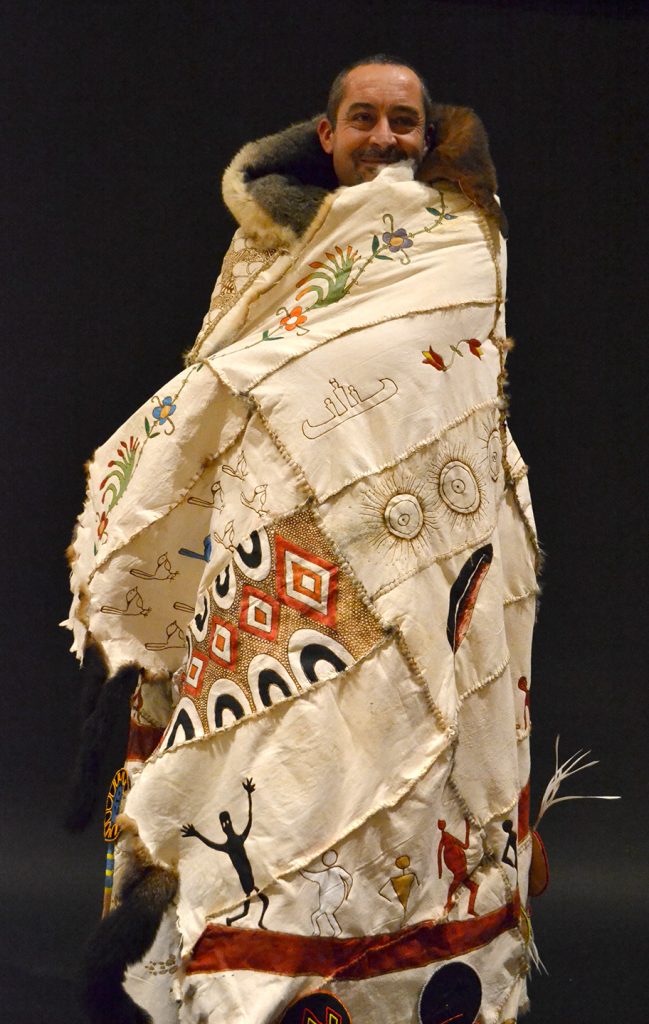Indigenous artists craft traditional garments
By Meredith Lauzon
A group of Indigenous artists from Canada and Australia gathered in Ottawa this month to hand-make two traditional garments that will be displayed next year at the Ottawa Art Gallery.
In the project, titled Wrapped in Culture, the ten artists – four from Canada and six from Australia – produced a traditional Australian possum-skin cloak and a traditional southern Albertan Siksika Blackfoot buffalo robe.
They also held free artist talks and workshops, at City Hall and the Carleton University Art Gallery, and shared skills with each other.
Once CUAG cleared the artists to burn impressions into the pelts without activating the university’s sprinkler system, Mitch Mahoney, 20, a “master burner” of the Barkindji, Yorta Yorta, and BoonWurrung nations in Australia, showed his method of hot-etching designs to the other artists.
Meanwhile, Ottawa-based artist Barry Ace, Anishinaabe band member of Ontario’s M’Chigeeng First Nation of Manitoulin Island, taught Mitch’s mother, Kerri Clarke, and sister, Molly Mahoney, 16, the intricate details of his beadwork while working in a corner of the gallery.
“The trick with beadwork, never think of the end. Always focus on where you are,” said Ace.
The project began when Winnipeg Métis artist Rosalie Favell was appointed an artist-in-residence in Australia. Favell was introduced to Kerri’s aunt, Indigenous artist Maree Clarke, who was working to revive the traditional art of possum-skin cloak making.
When Clarke began looking into the preservation of cloaks from historical times, she learned there were only six that remained in collections throughout the world.
“I immediately thought ‘I’ve got to find a way to bring them to Canada,’” recalled Favell. “So before I got back (to Canada) I started brainstorming on how to do this.”
Traditionally, southern Australian Indigenous children are given a possum-skin cloak made of three pelts at birth, and the cloak is added to by sewing on additional pelts as they age. The pelts are covered in burned symbols that indicate where children are from and which represent stories about their family.
These cloaks are now used for ceremonial practices such as naming rituals, but also for less traditional events, such as school graduations. Keeping with the old tradition, the cloaks follow their owners to the grave as they are wrapped around the deceased for burial.
Adrian Stimson of the Siksika Blackfoot in southern Alberta says that to the people of his nation, the buffalo was “everything.” They used each piece of a buffalo for everything from boats to children’s rattles, he said, and certain items were sacred.
So before embarking on his trip to Ottawa, Stimson spoke to his elders to better understand the history of the robes and reassure them that the artists’ work wouldn’t cross any forbidden lines.
Buffalo robes were highly coveted and traded by the Hudson Bay Company. Buffalo or plains bison were nearly exterminated in Alberta, but have recently been reintroduced to their historical habitat by Parks Canada.
Wrapped in Culture project manager Brittany Johnston, Anishinaabe from Ontario’s Serpent River First Nation, said through exchanging stories, the artists find connections with one another. Johnston said the possum skin-cloak and buffalo robe are both about capturing the histories of a person, family or community.
Johnston said that during this phase of reconciliation in Canadian society, when generations of wrongs against Indigenous people are being addressed with apologies and compensation, a project like Wrapped in Culture places importance on strengthening community, and the results belong to everyone.
She called it a “living art project.”
The garments will be displayed next October at the Ottawa Art Gallery, in an exhibit curated by Wahsontiio Cross, a PhD student at Carleton University and member of the Kahnawake Mohawk nation in Quebec.
Cross’s first day at the Ottawa Art Gallery at Arts Court was the same day the artists started to work, and although the new gallery is yet to be finished, she said that being able to watch them in action was helpful for her to visualize the exhibit for next fall.
Cross said she sees revitalization as central to this project, and described it as positive and forward-looking, because the artists are giving a piece of history to their communities.

